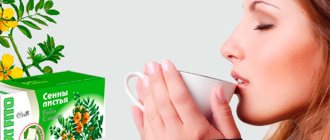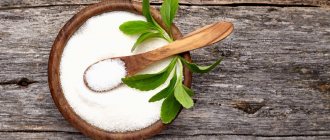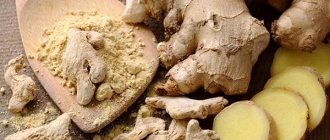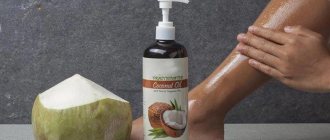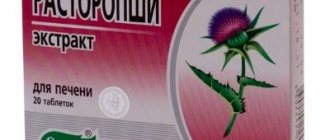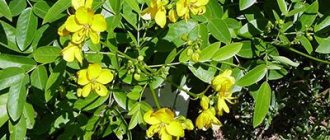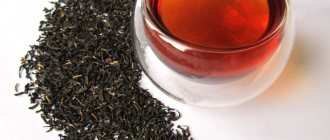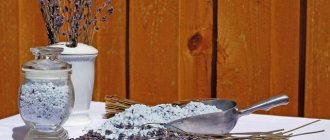Senna is a plant from the legume family, widely used in medicine. It has several names: cassia holly, African senna, Alexandrian leaf. The plant is a tropical shrub. The medicinal raw materials are the leaves and fruits of senna. It is grown and harvested on an industrial scale in Asia and Africa. It also grows in Russia - the climate of the Krasnodar Territory suits it.
The main and most pronounced pharmacological property of senna herb is a laxative.
Composition and medicinal properties of the herb
The plant contains:
- glycosides;
- flavonoids;
- organic acids;
- vegetable resins;
- plant alkaloids;
- anthraquinones (they are the ones that have a laxative effect).
Biologically active substances provide the following pharmacological effects:
- pronounced laxative;
- moderate diuretic;
- secretory;
- appetite stimulant;
- anti-inflammatory.
Indications for use of senna herb
Senna herb and preparations prepared from it are used in the following cases:
Retention of stool, constipation
Plant glycosides normalize the peristalsis of the intestinal wall, resulting in its emptying naturally. This medicine helps with constipation of atonic and hypotonic origin.
From the mechanism of action it follows that the use of senna for constipation of spastic origin should be used with caution or completely avoided
Diseases whose specific nature requires softening of stool
This effect is required for exacerbation of hemorrhoids, as well as for rectal fissures. This action is also relevant in the postoperative period after surgical interventions in the pelvic floor area.
We recommend reading: Medicinal properties and contraindications of galangal root, use for men, galangal tincture
Diseases of the liver and biliary tract
For diseases of the hepatobiliary system, senna’s ability to cleanse the body of waste and toxins and normalize the functioning of hepatocytes and the gallbladder is used. It must be taken into account that senna extract brings benefits for the liver and digestion in low quantities - in contrast to large doses, which have a laxative effect
Weight loss
The instructions for use for senna herb, as well as for preparations containing this medicinal raw material, do not contain information about whether this drug is intended for weight loss and weight loss. However, this result is achieved thanks to the pronounced laxative effect of the drug, cleansing the intestines and the subsequent cleansing of the body. The ability of senna extracts to normalize appetite and accelerate metabolic processes also indirectly contributes to weight loss.
For weight loss, senna grass is used together with dandelion, mint, nettle, parsley, and dill as part of herbal preparations. Mixtures of Alexandria leaf with dried fruits and honey are also used. It must be taken into account that prolonged use of products prepared from this medicinal plant material can lead to addiction. Before using the herb of Alexandria leaf, consultation with a therapist and nutritionist is necessary.
Use during pregnancy for bowel movements on the eve of childbirth
Information contained in different sources varies. Some mention that with frequent constipation in pregnant women, preparations based on senna relieve the condition. Others focus on the fact that, by causing increased intestinal motility, senna can provoke contraction of the uterine muscles, which will lead to premature birth.
In addition, the excessive loss of fluid that occurs when using senna is harmful during pregnancy. Therefore, the prescription of this herbal remedy to expectant mothers should be carried out on an individual basis after a detailed consideration of all the pros and cons of such treatment
Skin and hair care
Biologically active substances contained in the Alexandria leaf have the property of softening the skin and hair, as well as protecting them from exposure to direct sunlight.
There is information that in countries where the Alexandrine leaf grows, the medicinal properties of its extract are used as an anti-inflammatory agent for purulent skin lesions, as well as for infectious and inflammatory eye diseases of a bacterial nature. Sources on Arabian medicine say that senna herb is widely used to purify the blood, for diseases of the heart and joints.
We recommend reading: The benefits and harms of pine cones, properties and when is the best time to collect them
general information
Since the birthplace of the culture is not only Africa, but also Asia, in another part of the world senna received its Chinese name - Jue Ming Zi, or simply “Chinese grass”.
This is interesting! In China, there is even an incredible legend associated with senna grass, as if one Taoist monk consumed senna fruits all his life and, thanks to it, lived for more than 100 years with perfect hearing, vision and a slender body.
Today, people in China use cassia beans everywhere. There is an opinion that the senna plant is especially useful for those people who spend a lot of time at work at the computer and lead an inactive lifestyle, because the senna herb helps reduce fatigue and eye strain.
It is thanks to its many beneficial qualities that senna grass is a popular folk and pharmaceutical remedy for the treatment of a wide variety of diseases.
Senna grass
The Cassia culture, to which senna belongs, has other varieties:
- Cassia Fistula or Cassia Trumpet. Distributed in the territories of India, Southern Pakistan and Sri Lanka. And in Thailand, the flower of this tree is a national symbol. Both the inhabitants of the African continent and the inhabitants of South America are trying to cultivate it. The plant is tree-like in shape (up to 10-20 m in height) with bright yellow flowers that form long inflorescences in a raceme (about 20-40 cm). The fruits are brown-black, cylindrical in shape, and, as a rule, they do not open. A decoction of the beans of this tree is used as a laxative, to cleanse the intestines and against constipation.
- Cassia Hippophallus or Cassia Hippophales. This variety can be found only in Madagascar and only in wooded areas at altitudes of 0-499 m. The shrub stretches up to 20 m in height, with a trunk diameter of 50 cm. The tree bark is pale gray, and the leaves are arranged spirally in 13-20 pairs of plates and have short hairs. The flowers are collected in large panicles and have almost regular outlines. They are yellow in color. When the fruits ripen, cylindrical beans are obtained; the pod reaches 3 cm in width and up to 20 cm in length. Despite the fact that they have also proven themselves well as a laxative, for the inhabitants of Madagascar, the cassia wood itself, used as a building material, is of great value.
- Cassia Eremopita or Cassia Eremophila. It is found in the deserts of Australia, as well as in the subtropics of the southern hemisphere. This is a small tree or more often a shrub up to 2 m tall with a rounded crown. Characterized by a very high growth rate. The leaves are narrow and very small, and if conditions are too bad they can shrink to the appearance of needles. When flowering, it is dotted with abundant buds of bright yellow color with a moth shape. When ripe, the beans resemble acacia fruits.
Since cassia aquifolia or senna is most widespread and is used everywhere, it is worth dwelling on it in more detail.
Uses of senna herb
Senna leaves are used not only as a folk “homemade” fast-acting laxative, but are also included in medications.
Release form
Alexandria leaf is found on sale in pharmacies in various forms:
Vegetable crushed raw materials
The crushed plant mass is presented for sale packaged in bags from 25 to 300 grams, equipped with a description and instructions for use.
Senna extract tablets
This medicinal raw material is included in a number of drugs intended for the treatment of constipation:
- Regulax;
- Senadexin;
- Senade
Use of dry senna herb
Senna herb is used in the following ways:
Brewing
1 tbsp. l. crushed plant material, pour 200 ml of boiling water. Take 100-200 ml at night
Decoction
1 tbsp. l. pour dry medicinal raw materials with a glass of boiling water. Simmer in a water bath for 30 minutes, then remove from heat and set aside until completely cool. Strain the resulting broth and take half a glass at night.
Infusion
2 tbsp. l. dry crushed leaves pour 200 ml of boiling water. Leave for 6 hours. Take 1 tbsp one at a time. l. no more than 3 times a day before meals
Tea
1 tsp. pour a glass of cold water over the herbs, leave for 24 hours, then strain. There are indications that this method of preparing tea from Alexandria leaf allows you to avoid side effects in the form of spasms and cutting pain after use. You should take a glass of senna leaf tea at night.
The instructions for use indicate that senna preparations can be used not only by adults, but also by children over 6 years of age.
How to grow senna
Mowing grass: description, where it grows, beneficial properties
Gardeners prefer to propagate and grow senna by seed. To do this, you must first soak the seeds for 2-3 hours in warm water. After this, you can already sow them into the ground. The culture loves light soil, which contains a lot of peat. Heavy soils are not suitable for Senna.
Important! Residents of the middle zone and cold regions will find it extremely difficult to grow this plant, since it is very heat-loving. Germination and formation of the plant occurs at a constant warm temperature close to +21‑23ºС. In changeable weather, the most optimal conditions for senna are created in greenhouses.
After the senna has shown the first 2-4 pairs of leaves, it needs to be transplanted either into a pot or into open ground if the region is warm. In its permanent place, the plant begins to grow actively and develops very quickly.
How to grow senna
Plant diseases and pests
Fungal diseases such as cladosporiosis and cercospora can become a threat to senna in too cold conditions and excessive moisture.
Among the pests that can parasitize crops are aphids, leaf rollers and scale insects.
Senna herb contraindications
Absolute contraindications to the use of senna leaves, as well as any medicines containing an extract of this plant, are:
- intestinal obstruction, regardless of its origin;
- ulcerative spastic colitis, especially in the acute phase;
- pain and cramps in the abdomen of unknown origin;
- suspicion of appendicitis;
- suspicion of peritonitis;
- any acute inflammation of the intestines;
- cystitis;
- bleeding from a source in the gastrointestinal tract;
- uterine bleeding of any origin;
- hernia;
- perforated ulcer of the stomach and duodenum.
The herbal remedy should not be used if you are hypersensitive to any of the biologically active substances in the composition.
We recommend reading: Description of sleep herb, where it grows, uses and contraindications
Description of the plant
Immortelle grass: description, where it grows, application
Senna is a shrub or subshrub of small height, not exceeding 1 m. Senna grass is a typical perennial.
The root system is sparsely branched and goes deep into the soil. The leaf plates go alternately. Pairipinnate leaves have about 4-8 pairs of leaflets. The shape of senna leaves is lanceolate, pointed towards the top and has a solid edge. The leaves are attached to the axis using short petioles.
Cassia Eremophila
Senna grass is traditionally characterized by yellowish flowers (but sometimes they are white or pink), irregularly shaped. They all gather in a racemose inflorescence. It also has fruits - netted beans of a dark brown tone. Senna fruits are angular-heart-shaped, with a flat outline and a slightly wrinkled surface. They are about 2.5 cm wide and up to 5 cm long.
Important! The grass blooms in the summer - in July-August, and the fruits ripen in September.
What are the side effects of senna herb?
Undesirable side effects, especially in case of overdose, are possible:
- spasms of smooth muscles of internal organs;
- cutting pain in the abdominal cavity;
- indigestion;
- dyspeptic symptoms in the form of nausea and vomiting;
- bloating, increased gas formation;
- dizziness;
- heart rhythm disturbance;
- muscle cramps;
- confusion;
- brown tint of urine;
- electrolyte disturbances due to potassium loss;
- damage to the intermuscular plexus of the inner wall of the intestine;
- dark brown coloration of the walls of the large intestine.
If used incorrectly, Alexandria leaf can cause harm to the body. Long-term use leads to addiction. This condition is manifested by increased constipation due to dysfunction of peristalsis, narrowing of the lumen of the large intestine, which occurs due to constant stimulation of tone.
To avoid such situations, it is recommended to regularly change the type of laxatives if there is a need for prolonged use.
Useful properties of cassia
The benefits of Alexandrian cassia have been proven not only by many years of experience of supporters of alternative medicine, but also by numerous studies by scientists. The herb has laxative and diuretic properties. Senna helps cleanse the body of toxic substances without causing harm to health. Unlike medications, the plant rarely causes side effects.
The beneficial property of glycosides is to improve the functioning of the digestive organs. As a result, stool is restored, which is important for frequent constipation. The benefit of alkaloids is their analgesic effect. Flavonoids are considered beneficial substances that have a cleansing effect on the body. Due to the content of organic acids, pathogenic microorganisms are eliminated, which helps to normalize the microflora of the gastrointestinal tract. The most pronounced beneficial properties of the plant include:
- acceleration of metabolism;
- general strengthening effect on the body;
- anti-inflammatory effect;
- improving the appearance of the skin surface;
- diuretic and laxative effects;
- normalization of the heart muscle;
- analgesic effect.
Special Recommendations
Throughout the entire course of treatment with drugs containing senna, it is recommended to drink large amounts of liquid (3-3.5 liters per day) in order to replenish the volumes lost in feces. While using senna preparations, it is also necessary to consume a sufficient amount of fiber.
Indications for stopping the drug and seeking medical help are the absence of stool for 2 days while using senna in any form.
When treating with this drug, you must strictly follow the instructions of your doctor or the instructions for use.
Source
Other useful and medicinal plants
